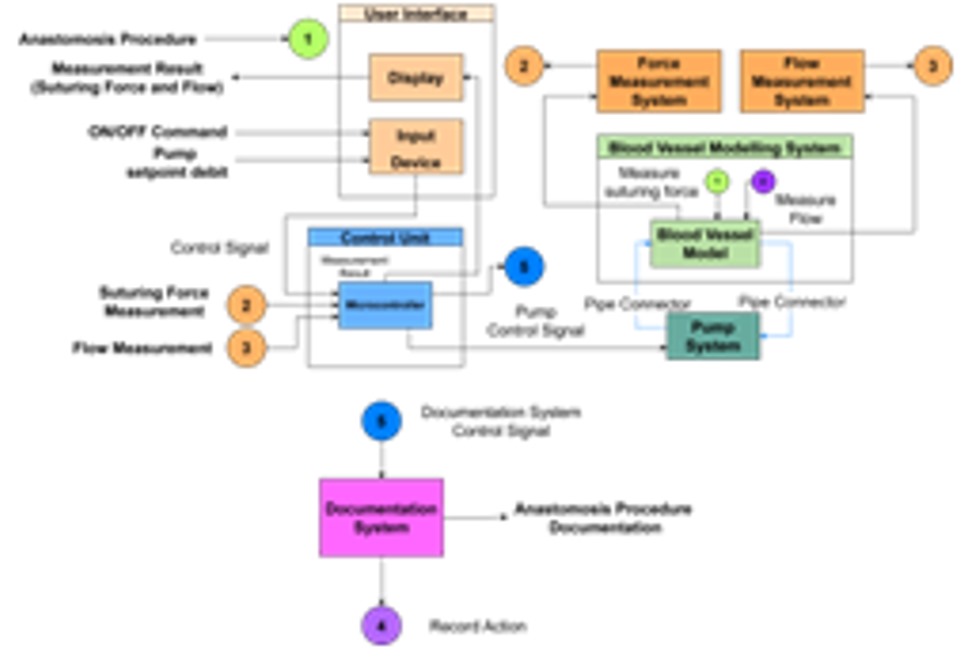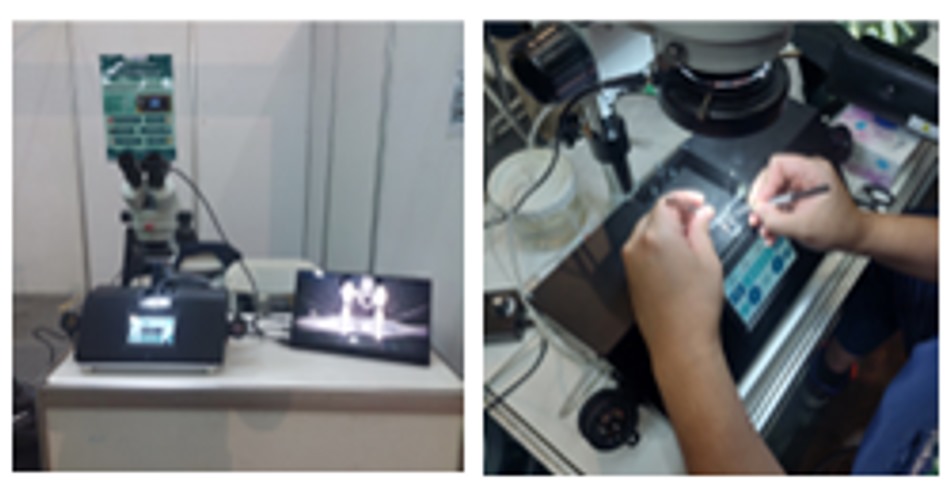Muhammad Shiddiq Sayyid Hashuro, Ph.D.
STEI-ITB
Reynaldo Averill A. P.
Fariz Iftikhar Falakh
Muhammad Daris Nurhakim
STEI-ITB
Abstract
While vascular anastomosis is an important skill that needs to be refined to perfection by a neurosurgeon, the training kit available doesn’t represent the actual condition encountered in surgeries. In this study, we have designed and implemented a medical phantom that solves this problem. The phantom has two main functions, which are similarity with real-life condition achieved by using PVA-H based blood vessels model and ability to give quantitative evaluation by measuring the suturing force applied to the blood vessel models and the flow rate of liquid before and after the procedure.
Keyword: End-to-end anastomosis, Medical Phantom, Suturing Force, Flow rate, PVA-H.
Introduction
The medical term “anastomosis” refers to joining two body channels, often used to repair malfunctioning channels caused by conditions like leakage or clotting. Types of anastomosis vary by application; for instance, vascular anastomosis repairs blood vessels and includes end-to-end, side-to-end, and side-to-side techniques. Neurology heavily relies on anastomosis procedures to
treat cerebrovascular diseases, requiring precise execution and extensive training. However, practicing this procedure is challenging due to risks with live patients and limited realistic training devices.
Common training kits include silicon tubes, surgical gloves, suture pads, animal vessels, cadaveric vessels, and polyvinyl alcohol hydrogel (PVA-H). Each has limitations, such as poor resemblance to live surgery, high costs, or limited availability. PVA-H, though effective due to its good transparency, lower surface friction resistance, and lower mechanical properties compared to silicone model, is costly for countries like Indonesia because PVA-H were only manufactured in some country like Japan and America. Furthermore, the device used to practice this procedure do not give any kind of feedback that can be used to evaluate how well the trainee did on the training, so any kind of evaluation must be provided by the trainer, which is very prone to subjectivity.
To address this need, we have developed a training device for medical use or usually called medical phantom for vascular anastomosis, that not only accurately mimic the condition encountered at surgeries, such as the characteristics of the blood vessels – namely the elasticity, diameter, viscosity and flow rate of the fluid running through the vessels. The device will also measure the force applied by the trainee to suture the vessels and evaluate the flow rate of liquid after it went through the anastomosis site. The force applied to the suture is measured to evaluate whether the trainee used too much force which can actually ripped or damaged the vessels during the procedure, while the flow rate is measured to analyze the cross-area reduction of the vessels at the anastomosis site.
Research Method
Medical phantom for end-to-end vascular anastomosis designed by combining nine subsystems, which some of them could be grouped together to form the main three subsystem of this medical phantom. The main three subsystem of this medical phantom are blood vessels modeling system, fluid distribution and measurement system, and suturing platform and force sensing system. There were also three integration subsystems, which are control unit system, power supply system, and casing system. Two of the subsystems (user interface system and documentation system) categorized as additional subsystems. Fluid distribution and measurement systems were the combination of pump system and flow measurement system.

Blood vessel model was created using PVA-H as the material. PVA-H dynamic viscoelasticity can be controlled by adjusting the concentration, degree of polymerization of PVA, or blending two kinds of PVA. The dimensions of the PVA-H created for this project had an outer diameter (OD) of 4 mm and an inner diameter (ID) of 3 mm. Blood mimicking fluid was created using the glycerin-water solution. It is also important to note that water was also used as blood mimicking fluid replacement for simplicity during the trial and error.
For the Fluid Distribution and Measurement System, a 12V DC Peristaltic Pump was used and configured so it can deliver a liquid flow rate ranging from 28 – 52 mL/minute, depending on the flow rate chosen by the user. On the other hand, the sensor used in this project was Sensirion SLF3C-1300F that can measure flow rate up to 65 mL/min.
Force Sensing System consists of several components, including a 120ohm strain gauge with pole, HX711 module, and dear nylon thread with reel Strain gauge with pole is used as the main component to measure suturing force. Four strain gauges are needed on the pole. These strain gauges are assembled into a full Wheatstone bridge circuit because in this case high accuracy value readings are required.
Raspberry Pi 4 Model B LPDDR RAM 4 GB was chosen as the main control unit, whereas Five- inch HDMI LCD (H) capacitive touch screen 800×480 was used as the screen for the medical phantom.
Discussion & Result
Based on the observation made by neurosurgeon, PVA-H/A15 (DMSO and water ratio 80:20 with PVA concentration 15%) was the best choice for blood vessel model with caliber 3-4 mm. Regarding the wall thickness, OD 4 mm and ID 3 mm represent similar wall thickness of real human blood vessel with the same caliber e.g. Internal Carotid Artery (ICA). The rule of thumb for wall thickness should be around 10% of outer diameter.
Experiment in fluid distribution and measurement system shows that anastomosis procedure conducted in the medical phantom should not result in an 85% area reduction or higher at the suturing spot, as the flow in those situation starts to decrease rapidly.
The usage of full Wheatstone bridge by utilizing deformation on the pole is a good pick for the force sensing system because it can produce accurate and precise values. The measurement results are obtained with the appropriate load but there is a slow shift in value up to the error limit Furthermore, to darify the results of the suturing force reading at crucial conditions, the value at idle conditions can be ignored. This can be done by using a high pass filter to see the data more clearly when the user pulls the vessel model to be suture or when knotting the suturing thread.

Conclusion
PVA-H/A15 was the best choice for a blood vessel model with a caliber of 3-4 mm.
The distribution system can deliver a liquid with a flow rate ranging from 28 to 52 mL/min, which can be selected by the user. The fluid measurement system can measure flow rates up to 54 mL/min and determine the threshold of area reduction caused by the anastomosis procedure conducted in the phantom, which is 85%.
Usage of four strain gauges assembled into a full Wheatstone bridge circuit will produce values with high accuracy and precision. In addition, the strain gauge has a high level of sensitivity so that it can read changes in value even though it only gets a suturing force below 0.2 Newton.